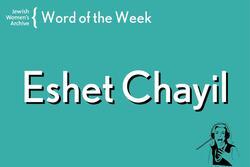Singing Eshet Chayil to My Four Matriarchs
After reciting the same twenty-two verses every Friday evening for five years now, I am an expert on every line, every single word. I recite the poem from brute memorization, never having to glance at the siddur, but still looking at it as a sign of respect, and so that I seem humble when visitors come over for Shabbat. I love how long I can stretch out the end of line 20 and let the words “על כלנה” (in English, “them all”) linger on my tongue as I elongate the syllables like I’m stretching out the cheese in a mozzarella stick, holding the note until I’m out of breath. This part of the poem is the crescendo. I sing the last two lines and then my family claps their hands and tell me, “יישר כוח” as I close the siddur and wait again until next week to sing Eshet Chayil.
Right before I close the siddur, I glance quickly at the twenty-two verses and pick one. I highlight this lucky verse in front of my family. I read the verse both in Hebrew and in English so that everyone understands it. Then I pick a woman in the room. Usually, my options are quite varied between my mother, aunt, Bobba, and Savta. After I select the woman in the room who I want to honor, I take on the role traditionally attributed to a Jewish husband, and I attribute the chosen verse to the chosen woman in the room. Each week, I pick a different verse that relates to the characteristics or actions I want to highlight in the four female figures in my life.
The real challenge is relating these verses, believed to be written by King Solomon as part of the Book of Proverbs nearly 3,000 years ago, to modern-day women. Some verses such as, “She makes covers for herself; her clothing is linen and purple,” seem to have no connection to the modern, progressive woman and her daily life. Yet I pluck at the underlying meaning of my interpretation of the text and make it relevant and empowering to the woman in my life. In this case, I interpret it as a woman being independent and resourceful by working on something for herself.
Traditionally, Eshet Chayil is said by the man of the family in honor of his wife. My dad never said it to my mom because it was not my family’s tradition, but it was the tradition of the Chabad house that my family went to growing up. Every Friday after the traditional Shabbat meal, but before the bentshhing of Birkat Hamazon , the rabbi and the other men in the community would sing zemirot, Eshet Chayil being one of them. I liked the sound of the poem when it was sung out loud, and I decided to take it upon myself to be attentive when the men would sing it. Slowly but surely, with a little help along the way from my dad, I was able to learn the entire poem. I believe I started singing Eshet Chayil with my dad singing along when I was in seventh grade. He was my training wheels, helping me ride my Eshet Chayil bike. Once I was ready, we took off the training wheels and I started chanting Eshet Chayil by myself.
At Chabad I was accustomed to only men singing Eshet Chayil, specifically the rabbi. Even though I was not a man, and not a rabbi, I reclaimed Eshet Chayil and put my own spin on it. Instead of using the poem the way a husband would honor his wife for taking care of the entire family, I chose to use Eshet Chayil as my way of thanking and expressing the awe that I have for these female role models in my family. My mom is the hardest worker I know. She wakes up at 5:30 in the morning to get on business calls and then spends hours organizing our schedules just to make sure we get to do all the extracurriculars and sports we want to do. My Bobba has hosted Shabbat dinner at her house every single weekend for the past five years, always looking for an opportunity to bring her children and grandchildren together. My Savta will always sit there patiently with me as I sound out a Hebrew word that I am unfamiliar with, gently guiding me along the way and fostering my love of Hebrew. My aunt calls me on long car rides or talks to me when we are together over Thanksgiving, giving me advice on how to navigate my teenage years. I take a moment each week to express my love and gratitude for these four women in my life, and Eshet Chayil is my outlet for doing that. Despite Eshet Chayil depicting women as childbearers and housewives, I depict the women in my life as fierce intellectuals, resourceful entrepreneurs, and strong athletes.
Having sung Eshet Chayil for five years, I am still as enamored with it as I was the first time I sang it. This is not about the singing though. Eshet Chayil used to be about loving my mother and thanking her for simple things like taking me to swim practice, or going on bike rides with me along the canal in Phoenix where we live. Now I am almost seventeen years old, and I am dipping my toes into the pond of womanhood. As I change, my relationship with my mom has changed as well. She is still my mom, but she also is my best friend. I sing Eshet Chayil as a woman, singing it in honor of another woman. I use my power as a woman to praise the other women around me and show them that I am watching, learning, and constantly trying to live up to their amazing feats and accomplishments that inspire me.
This piece was written as part of JWA’s Rising Voices Fellowship.







